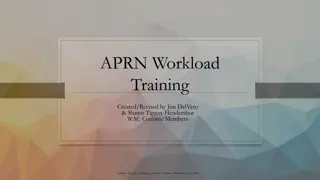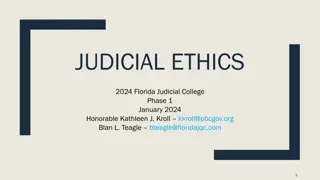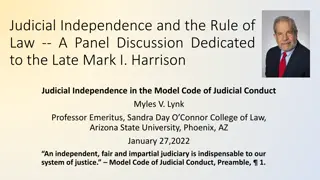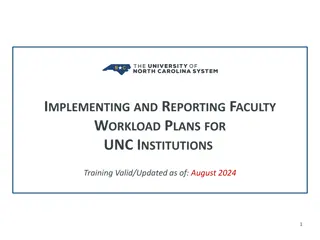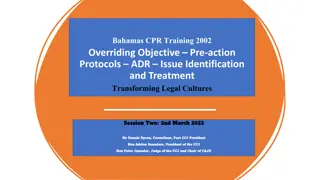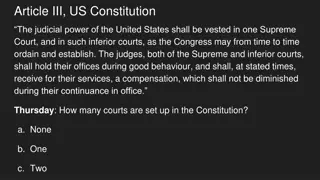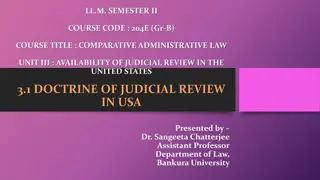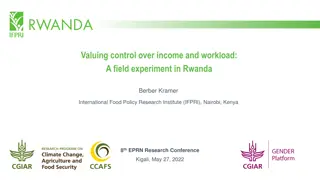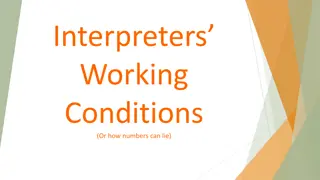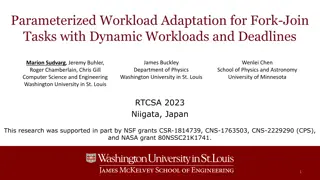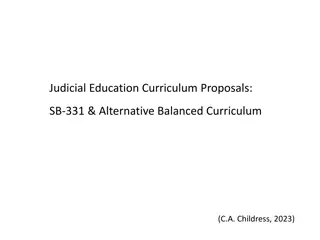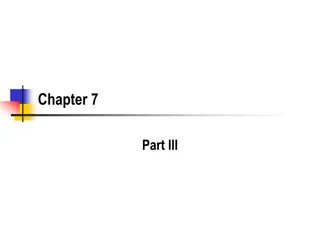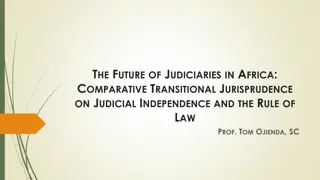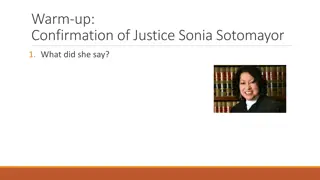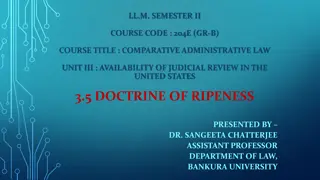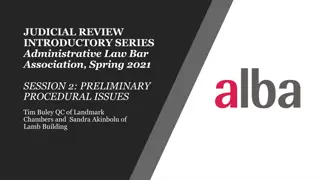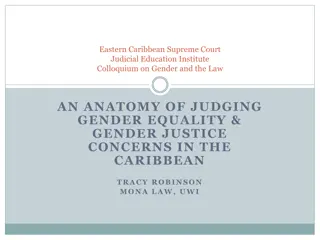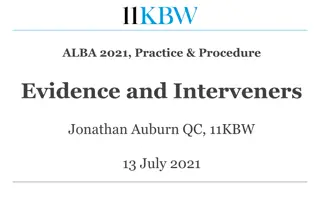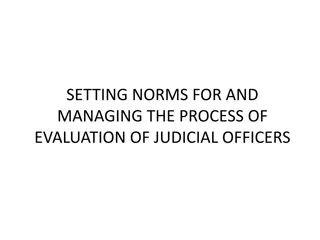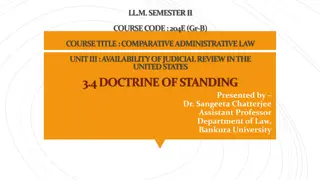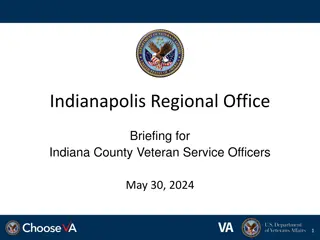Virginia Judicial Workload Assessment 2024 Overview
The Virginia Judicial Workload Assessment 2024 aims to provide an objective measure of judicial workload for determining judgeships. It involves a comprehensive approach using quantitative and qualitative data to assess the need for judges in Circuit, General District, and Juvenile & Domestic Relations Courts. The assessment includes time studies, quality adjustments, adequacy surveys, focus groups, and Delphi panels, all overseen by the Judicial Needs Assessment Committee (JNAC). The current practice involves training sessions, benchmarking, and forming parameters for the study.
Download Presentation

Please find below an Image/Link to download the presentation.
The content on the website is provided AS IS for your information and personal use only. It may not be sold, licensed, or shared on other websites without obtaining consent from the author. Download presentation by click this link. If you encounter any issues during the download, it is possible that the publisher has removed the file from their server.
E N D
Presentation Transcript
Virginia Judicial Workload Assessment 2024 Senate Courts of Justice Committee and the House Courts of Justice Committee August 12, 2024 Brian J. Ostrom, Ph.D. National Center for State Courts
Develop an accurate profile of the work of Circuit, General District, and Juvenile & Domestic Relations Court judges Purpose of the Virginia Judicial Workload Assessment Provide an objective measure of judicial workload for use in determining judgeships
Judicial Workload Assessment Empirically-based method to determine the need for judges Comprehensive approach using quantitative and qualitative data NCSC has used this approach in approximately 40 states Third study in Virginia (2012, 2017, 2024)
Virginia Judicial Workload Assessment Current Practice What is Formation of Judicial Needs Assessment Committee (JNAC) JNAC 17-members comprised of judges and clerks from all court levels Time Study Provide project guidance and oversight Quality Adjustment What should be Initial Planning Meeting held in January 2024 Adequacy Survey Set parameters for 2024 study Focus Groups Delphi Panels
Virginia Judicial Workload Assessment Time Study (30 Days) Current Practice What is Circuit Court - April 8 to May 8, 2024 GDC and JDR - April 22 to May 22, 2024 Benchmark of current practice Statewide participation Accurate measure of average time per case Case weights describe what is JNAC Time Study Quality Adjustment What should be Adequacy Survey Focus Groups Delphi Panels
Virginia Judicial Workload Assessment Time Study Training Current Practice What is Prior to time study Three live webinars per court level Recorded webinar JNAC Time Study Quality Adjustment What should be Time Study Participation Adequacy Survey Circuit Court 95% General District Court 92% Juvenile and Domestic Relations 92% Focus Groups Delphi Panels
Calculating Resource Need Three elements needed to calculate judicial need Accurate and valid filing counts Case weights Judge year value
Calculating Resource Need An Example Number of new filed cases Time (mins) Workload (mins) * = Case Type A 1,000 * 300 = 300,000 Case Type B 3,000 * 50 = 150,000 Case Type C 200 * 125 = 25,000 4,200 475,000
Calculating Resource Need An Example Number of new filed cases Time (mins) Workload (mins) * = Case Type A 1,000 * 300 = 300,000 Filings Case Type B 3,000 * 60 = 180,000 Case Type C 250 * 120 = 30,000 4,250 510,000
Calculating Resource Need An Example Number of new filed cases Time (mins) Workload (mins) * = Case Type A 1,000 * 240 = 240,000 Case Weights Case Type B 3,000 * 60 = 180,000 Case Type C 250 * 120 = 30,000 4,250 450,000
What is a Case Weight? Minutes of Activity Case Weight = Filings Example: A case weight of 60 minutes means that, on average, a case of this type requires 60 minutes of judge time from filing through post- disposition activity.
Calculating Resource Need An Example Number of new filed cases Time (mins) Workload (mins) * = Case Type A 1,000 * 240 = 240,000 Case Type B 3,000 * 60 = 180,000 Case Type C 250 * 120 = 30,000 4,250 450,000 Workload
Calculating Resource Need An Example
Calculating Resource Need An Example How much time is available in a year to handle cases?
Judge Day Separated into two parts: Case-related matters: Time spent handling cases both on-bench and off-bench Non-case-related matters: Time spent on functions not directly case-related
Non-Case-Related Events Non-Case-Related Administration General Legal Research Judicial Education and Training Committee and Other Meetings Community Activities and Public Outreach Work-Related Travel
Example: Judge Day Calculation Total Hours Per Day Lunch and Breaks Total Working Hours Per Day Non-Case-Related Time Total Case-Related Time per Day = - - 8.5 1.0 7.5 1.7 5.8
Example: Judge Year Value 216 days x 5.8 hours/day x 60 minutes = 75,618 minutes Each FTE judge has 75,618 minutes per year for case-related work
Calculating Resource Need An Example How much time is available in a year to handle cases? 216 days x 5.8 hours/day x 60 minutes = 75,168 minutes
Calculating Resource Need An Example
Next Steps After Time Study Adequacy of time survey Focus groups Delphi sessions Preliminary results meeting of JNAC Final meeting of JNAC Final report and project end
Virginia Judicial Workload Assessment Current Practice What is Adequacy Survey Web-based survey Input from judges statewide Identify activities, if any, where you believe additional time would allow you to more effectively handle your cases Used by Delphi groups to identify tradeoffs, bottlenecks, or areas of perceived resource constraints June 2024 JNAC Time Study Quality Adjustment What should be Adequacy Survey Focus Groups Delphi Panels
Virginia Judicial Workload Assessment Current Practice What is Focus Groups Series of 6 focus groups -- meet with judicial officers who handle different types of cases Judicial officers from large and small jurisdictions Obtain information on the way that cases are currently handled Identify proven efficient and effective case processing policies and strategies Help identify challenges or bottlenecks to effective case processing July 22 24 JNAC Time Study Quality Adjustment What should be Adequacy Survey Focus Groups Delphi Panels
Virginia Judicial Workload Assessment Current Practice What is Quality Adjustment Sessions (Delphi) Series of 4 Delphi panels (2 Circuit, 1 GDC, 1 JDR) Structured method for assessing reasonableness of case weights Gather expert opinion on key case-related activities Think explicitly about how specific types of cases are handled Discuss time required for efficient and effective practices July 29 August 1 JNAC Time Study Quality Adjustment What should be Adequacy Survey Focus Groups Delphi Panels
JNAC and Project Completion Preliminary results meeting of JNAC (July 10) Review time study results Review adequacy of time survey results Final meeting of JNAC (August 14) Reconcile results from all phases of the study Finalize the weighted caseload model Final report Draft report in early September Final report in mid-September
Thank You Brian J. Ostrom, Ph.D. Bostrom@ncsc.org



